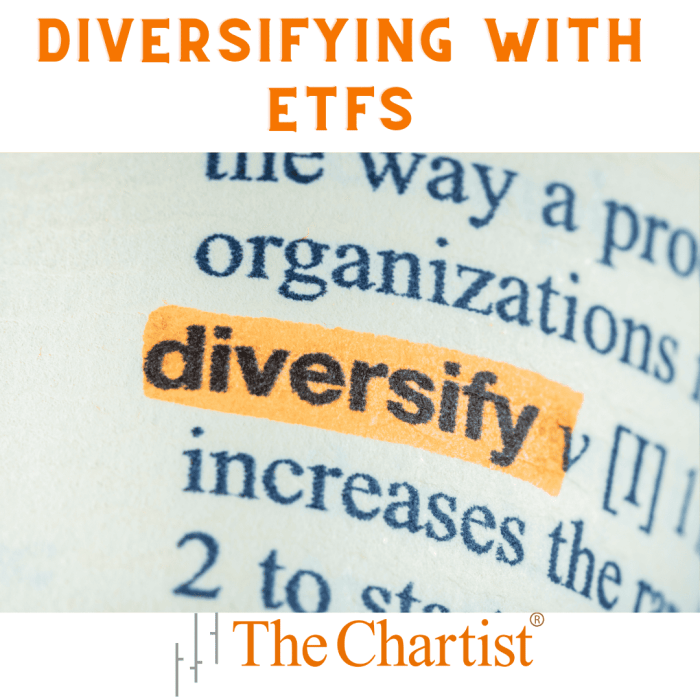
With Diversifying with ETFs at the forefront, this paragraph opens a window to an amazing start and intrigue, inviting readers to embark on a storytelling journey filled with unexpected twists and insights. ETFs, or Exchange-Traded Funds, offer a simple yet effective way for investors to diversify their portfolios and minimize risk. Let’s delve into how these investment tools can help you achieve your financial goals.
Introduction to ETFs
ETFs, or Exchange-Traded Funds, are investment funds that are traded on stock exchanges, similar to individual stocks. They differ from mutual funds in that they are traded throughout the day at market prices, while mutual funds are only priced at the end of the trading day. ETFs also have lower expense ratios compared to mutual funds.
Popular ETFs and Their Underlying Assets
- SPDR S&P 500 ETF (SPY): This ETF tracks the performance of the S&P 500 index, which consists of 500 of the largest publicly traded companies in the United States.
- Invesco QQQ Trust (QQQ): This ETF tracks the performance of the NASDAQ-100 Index, which includes 100 of the largest non-financial companies listed on the NASDAQ stock exchange.
- iShares MSCI Emerging Markets ETF (EEM): This ETF provides exposure to stocks of companies in emerging markets such as China, Brazil, and India.
Benefits of Investing in ETFs for Diversification
- Instant Diversification: ETFs offer exposure to a diversified portfolio of assets within a single investment, reducing risk compared to investing in individual stocks.
- Liquidity: As ETFs are traded on stock exchanges, they provide liquidity, allowing investors to buy and sell shares throughout the trading day.
- Low Costs: ETFs typically have lower expense ratios compared to mutual funds, making them a cost-effective investment option for diversification.
Benefits of Diversification with ETFs
Diversification is a key strategy in investing to reduce risk and enhance portfolio stability. Exchange-Traded Funds (ETFs) offer a convenient way to achieve diversification by spreading investments across different asset classes.
Spreading Risk Across Different Asset Classes
ETFs provide exposure to a wide range of assets such as stocks, bonds, commodities, and real estate within a single investment vehicle. By investing in an ETF, investors can effectively spread their risk across various asset classes, reducing the impact of volatility in any single asset.
Comparing Diversification Benefits of ETFs versus Individual Stocks
Unlike individual stocks, which are subject to company-specific risks, ETFs offer diversification across multiple companies and industries. This reduces the risk associated with the performance of any single stock and provides a more balanced exposure to the overall market.
Enhancing Portfolio Stability with ETFs
ETFs can help enhance portfolio stability by providing exposure to different sectors and regions, reducing concentration risk. For example, an investor can invest in a technology ETF to gain exposure to the tech sector without relying on the performance of a single tech company. This diversification helps to mitigate losses in case of underperformance in a specific sector or region.
Strategies for Diversifying with ETFs

Investors can employ various strategies to diversify their portfolios using ETFs. Sector-specific ETFs, international ETFs, and thematic ETFs play key roles in achieving diversification.
Sector-specific ETFs for Diversification
Sector-specific ETFs focus on a particular industry or sector, such as technology, healthcare, or energy. By investing in these ETFs, investors can spread their risk across different sectors of the economy. For example, if one sector experiences a downturn, the impact on the overall portfolio can be minimized by the performance of other sectors. This strategy allows investors to benefit from the growth potential of specific industries while reducing exposure to risk.
International ETFs for Portfolio Diversification
International ETFs provide exposure to foreign markets, allowing investors to diversify geographically. By investing in international ETFs, investors can reduce their reliance on the domestic market and gain access to opportunities in other countries. This strategy helps to mitigate the risk associated with economic and political factors that may impact a single market. Additionally, international ETFs can offer exposure to industries or sectors that are not well-represented in the domestic market, providing further diversification benefits.
Thematic ETFs for Targeting Market Trends
Thematic ETFs focus on specific trends or themes, such as renewable energy, cybersecurity, or artificial intelligence. By investing in thematic ETFs, investors can capitalize on emerging market trends and industries with growth potential. This strategy allows investors to align their portfolios with their beliefs, interests, or expectations about the future. Thematic ETFs can be used to complement existing investments and enhance diversification by adding exposure to niche areas of the market.
Portfolio Diversification

Portfolio diversification is a risk management strategy that involves spreading investments across different asset classes, industries, or geographical regions to reduce the overall risk of a portfolio. By diversifying, investors aim to minimize the impact of volatility in any single investment on the overall portfolio performance.ETFs can be an effective tool for achieving portfolio diversification due to their ability to provide exposure to a wide range of assets within a single investment.
ETFs are designed to track the performance of a specific index, sector, or commodity, allowing investors to gain diversified exposure without having to purchase individual stocks or bonds.
Combining Different ETFs for Diversified Portfolio
When combining different ETFs, investors can create a diversified investment portfolio tailored to their risk tolerance and financial goals. For example, an investor looking for a balanced portfolio could combine ETFs that focus on different asset classes such as stocks, bonds, and commodities.
- Equity ETFs: These ETFs track the performance of a specific stock market index, providing exposure to a broad range of companies across various industries.
- Bond ETFs: Bond ETFs invest in a portfolio of fixed-income securities, offering investors access to government bonds, corporate bonds, and municipal bonds.
- Sector ETFs: Sector ETFs focus on specific industries such as technology, healthcare, or energy, allowing investors to target areas of the market they believe will outperform.
By combining these different types of ETFs, investors can create a diversified portfolio that can help mitigate risk and potentially enhance returns over the long term.
Portfolio Management
Portfolio management plays a crucial role in maintaining a balanced investment portfolio by ensuring that the allocation of assets aligns with the investor’s goals and risk tolerance. It involves making strategic decisions to optimize returns while managing risks effectively.
Active Management of ETFs in a Portfolio
ETFs can be actively managed within a portfolio by regularly monitoring their performance, tracking the underlying assets, and making adjustments based on market conditions. Active management allows investors to capitalize on opportunities and mitigate potential risks.
Considerations for Rebalancing a Diversified Portfolio with ETFs
- Regularly review the portfolio: Periodically assess the performance of ETFs in the portfolio to ensure they are aligned with the investment objectives.
- Asset allocation adjustments: Rebalance the portfolio by adjusting the allocation of assets to maintain the desired risk-return profile.
- Market conditions: Consider market trends and economic factors that may impact the performance of ETFs and make adjustments accordingly.
- Tax implications: Take into account tax consequences when rebalancing the portfolio to minimize tax liabilities.
- Cost-effectiveness: Evaluate the costs associated with buying and selling ETFs when rebalancing the portfolio to optimize returns.
In conclusion, Diversifying with ETFs provides a solid foundation for building a well-rounded investment portfolio. By utilizing ETFs, investors can access a wide range of assets, mitigate risk, and potentially enhance their returns. Whether you’re a novice investor or a seasoned pro, incorporating ETFs into your strategy can lead to long-term financial success.
Answers to Common Questions
How often should I rebalance my ETF portfolio?
It is recommended to rebalance your ETF portfolio annually or whenever your asset allocation deviates significantly from your target.
Are ETFs a good option for long-term investing?
Yes, ETFs can be an excellent choice for long-term investing due to their diversification benefits and low costs compared to mutual funds.





